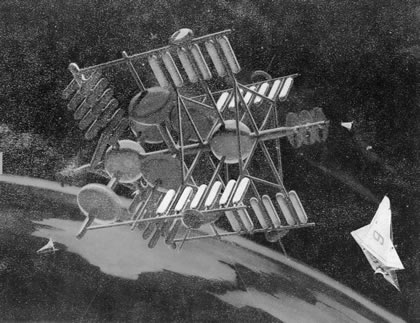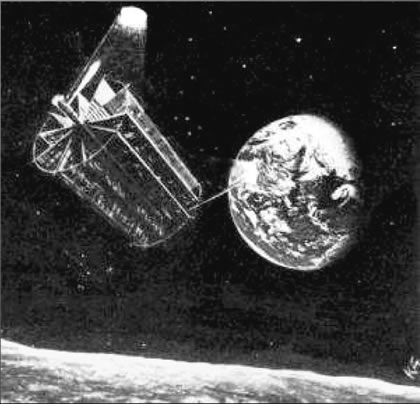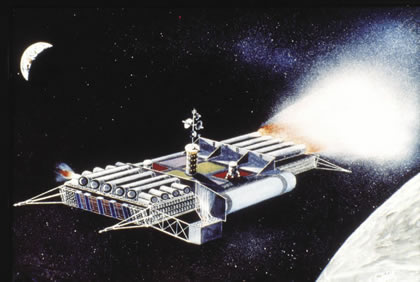KRAFFT EHRICKE
The Moral Imperative of Space Exploration
by Marsha Freeman
March 2017
A PDF version of this article appears in the March 24, 2017 issue of Executive Intelligence Review and is re-published here with permission.
By expanding through the Universe, man fulfills his destiny as an element of life, endowed with the power of reason and the wisdom of the moral law within himself.
—Krafft Ehricke
Krafft Ehricke was one of the most remarkable men of the Twentieth Century, whose work, more than 30 years after his death, embodies the moral imperative and provides the guideposts along the pathway to the future. Although his contributions to space exploration spanned the entire range of scientific and engineering concepts, from the utilization of Earth orbit, to the industrial development of the Moon, and exploration throughout the Universe—most of which, decades later, still remain to be realized—what distinguished him from other talented and creative visionaries was his uncompromising and passionate commitment to the future of mankind.

Krafft Ehricke |
To Krafft Ehricke, space exploration was not simply an end in itself—no matter how important that practical end may be—but embodied the rekindling of the noblest qualities of humanity. The incorporation of man into the Universe would be a concrete expression of his creative potential, and that of the Universe, itself. In his view, the mastery of the universe would require that mankind recapture the morality as well as the creative qualities that were under threat, and almost entirely destroyed, by the anti-human, anti-growth, and anti-science Malthusian disease of the 1960s. He was able to see that the logical consequence of this self-destructive pathway could be the very end of civilization. This gave great passion and urgency to his life’s work, dedicated to make available to mankind the alternative “extraterrestrial imperative,” to realize the great potential that lies within civilization, and just beyond the Earth. But in order to accomplish this evolution of man, mankind would have to marshal not only his science and technology, but “the moral law within himself.”
One may wonder why Krafft Ehricke’s name is not a household word in the history of spaceflight, like that of Wernher von Braun, who, in fact, lauded Krafft Ehricke’s contributions to his own work. The reason is that Krafft Ehricke never bowed to popular opinion. He never changed or “toned down” his thinking in order to become acceptable to the ideological mores of the time. While his universal principles were recognized and greatly admired by his peers, with the zero growth cultural paradigm shift of the late 1960s, they had become “unpopular.”
View full size
IAF
Krafft Ehricke at the 1955 annual congress of the International Astronautical Federation, Copenhagen. |
We came into contact with Krafft Ehricke after he had read the April 1981 issue of Fusion magazine, with a cover story on using fusion propulsion for colonizing space. He wrote a letter to the editor, stating that he had also developed concepts for using fusion energy in space. The editor invited him to contribute to the publication, which he happily did. Krafft Ehricke’s concepts for the advanced fusion propulsion that could take man beyond the Moon, followed upon his development, in the 1960s, of the world’s first energetic liquid hydrogen upper stage, which earned him the moniker, “father of the Centaur rocket.” The Centaur opened up the entire Solar system for exploration by the robotic representations of man’s intelligence.
While an Associate Editor of Fusion, I met Krafft Ehricke in October 1981 at his home in La Jolla, California. He showed me a file of letters from publishers, rejecting his manuscript for a 1971 book, titled, “The Extraterrestrial Imperative.” The publishers objected that the book was “too optimistic,” and promoted technologies such as nuclear energy, which were “unpopular.” The book has never been published.
When the Fusion Energy Foundation and the Schiller Institute were organizing a Krafft Ehricke Memorial Conference in 1985, following his death in December the previous year, a German-born scientist at NASA who was asked to participate, declined, saying that Krafft Ehricke stubbornly would not change or adapt his ideas to make them more acceptable. This is the societal sickness that Krafft Ehricke passionately fought against his entire life.
To Krafft Ehricke, there was no compromise with principles or the sanctity of the human mind, which was a central characteristic of his philosophical outlook. When discussing how he mentally survived Nazi rule in Germany, in an interview, excerpted in a 1960 book by space historian Shirley Thomas, Men of Space, Krafft Ehricke said he
always had the tendency to reserve ardent judgment on important things. I would go along only so far, then I just wouldn’t be told. No matter what it was, what the field, I wanted to think it out for myself. This was instinctive at first; later I was consciously afraid to surrender my capability of judgement. With the change in government, the advent of Hitler in 1933, this trait protected me—though it also got me into great difficulty . . . it helped me very greatly in holding a line of thought in the Nazi era. . . . I like to paraphrase the saying ‘My home is my castle.’ To me, my mind is my castle. A part of it no one may enter. . . . I must have this ultimate, internal refuge, in which I am completely myself; only then am I really an individual.
Today, due to the demoralization in much of the U.S. space community, despite stunning advancements, such as long-term living and working in space, exploring every major body in the Solar system, and increasingly uncovering the secrets of the universe, scientists have, in many cases, accepted limits on their vision for the future. Krafft Ehricke insisted that there are no limits on man, except those that he imposes on himself.
The Power of Reason
Krafft Ehricke never doubted that man would develop the technologies that would take him into space. But in 1957, even before the opening of the Space Age with the launch of Sputnik, he crafted what he considered to be most crucial—the philosophical worldview that should guide whatever progression of technologies would be developed to explore space. His three laws of astronautics were included in an article under a title curious for the usual writings about space policy: “The Anthropology of Astronautics” (see page 3, this issue).
Krafft Ehricke’s 1957 “Three Fundamental Laws of Astronautics” state:
- Nobody and nothing under the natural laws of this universe impose any limitations on man except man himself.
- Not only the Earth, but the entire Solar system, and as much of the universe as he can reach under the laws of nature, are man’s rightful field of activity.
- By expanding through the Universe, man fulfills his destiny as an element of life, endowed with the power of reason and the wisdom of the moral law within himself.
The ultimate anthropological meaning of space flight, Krafft Ehricke says in the article, will be mankind’s ability to “live elsewhere.”
In 1970, when the zero growth counterculture was becoming hegemonic and Krafft Ehricke was preparing the manuscript for his book, The Extraterrestrial Imperative, he created a chart to make explicit why development, representing a Renaissance view of man, was imperative. The graphic depicting Growth Versus No Growth, makes starkly clear what the consequence of a philosophy of limits would be. While the choice of growth leads to an educated population, international cooperation, and advances in technology and science, the “No Growth” pathway leads to regional chauvinism, geopolitics, mass starvation, epidemics, and war. Look around the world before you, and you see the consequences of the “No Growth” path that Krafft Ehricke warned, more than 40 years ago, would result from a bestial view of mankind.
View full size
EAP
In November 1981, Krafft Ehricke, accompanied by his wife, Inge, joined Helga Zepp-LaRouche on a speaking tour in Germany. Here, he is speaking to the European Labor Party. |
The depth of Krafft Ehricke’s understanding that it was not technology, per se, that would enable man to create new civilizations beyond Earth, but a revolution in cultural, moral, and political values—those embodied in the European Renaissance, the German Classics, and the United States Constitution—found a coherence with those of the Schiller Institute, which was founded by Helga Zepp-LaRouche in 1984. Moreover, the Institute, and other organizations founded by Lyndon and Helga LaRouche, were engaged in a parallel fight to create a cultural and political paradigm shift, back to the Renaissance ideals that had created the New World.
The Institute was founded to promote a return to classical culture, scientific advance, and economic development, as the alternative to the destructive economic, geopolitical, and counterculture policies that were destroying the Western Alliance, and the future of mankind. Krafft Ehricke joined the Advisory Board of the Schiller Institute.
Helga Zepp-LaRouche described this coherence of ideas: Like herself, she said, Krafft Ehricke
was also convinced . . . that only through space travel, only when man lifts his eyes from the Earth, looks into the stars and actually thinks what his role can be, can we achieve what Schiller called the dignity of man. And only if we start to think about space, and the colonization of space, will the Age of Reason that the great humanists of European civilization were thinking of accomplishing, be possible. That was the belief of Schiller, that was the belief of Krafft Ehricke. The fact that man is capable of reason, even under the most horrible condition of crisis, is our most fundamental belief.
In November 1984, the Schiller Institute held its third international conference. Unable to attend due to illness, Krafft Ehricke sent the following message to the meeting, locating his prescription for the future of mankind in space, within the long sweep of history that should inform mankind’s future path:
Greetings to the Friedrich Schiller Institute, to its Chairman, Helga Zepp-LaRouche; to its goal of a strong, revived American alliance with Europe, and to the defeat of the neo-Malthusian ’Green’ parties menacing Western Europe.
I have been from the Moon to light years out and never found a limit to growth. . . . Growth is the increase in knowledge, in wisdom, in the capacity for growing in new ways. Crises must be solved by leaping over the apparent limits to growth. . . . At the present point in history, our highly technological civilization faces another crisis of energy, materials, production space, and means of material processing. But man’s capacity for reason allows him to establish a ”third earth” in the extraterrestrial environment based on a more concentrated form of energy—nuclear fission and fusion. . . . If four or five or six billion people will fall back on a lifestyle of a very embryonic mankind, it will destroy mankind by billions, and it will devastate the biosphere.
Civilization is the ascendancy beyond brutality, beyond the recognition of plurality, the recognition that there are various ways to live and in which to explore nature. . . . Medieval European Civilization, frozen in the narrowness of its small, rigidly controlled communities and tightly bound to all-powerful religious dogmas, was in the Twelfth and Thirteenth Centuries dangerously close to becoming another static civilization, like those of ancient China, Japan, India, or the Incas on this continent. The sudden recognition that here there was the wide and beautiful Earth waiting to be taken by man, overwhelmed and emboldened the great thinkers of that time. . . . This was the crowning achievement of the Renaissance.
Now we begin to realize that the Solar system, and probably even parts of this Galaxy, can be ours. The consequences, for all phases of human existence, of the practical application of the second law of astronautics, during the coming centuries, almost defy our imagination, just as the world of today would be almost inconceivable to the Renaissance pioneers. We today are merely the shipbuilders for the men and women who will enter a new era of discoveries and lay the foundations for those who will come after them, those who will develop planetary technologies and create cosmic civilizations.
Krafft Ehricke’s assertion that “civilization is the ascendancy beyond brutality,” was under existential threat, no different than that under fascism in the 1930s. On Nov. 28, 1981 Krafft Ehricke gave a presentation in New York City, having just returned from a speaking tour in Europe with Helga Zepp-LaRouche.

EIRNS
Upon return from his European trip, Krafft Ehricke related to this author his serious concern about the political situation he witnessed in Germany. |
Riding in the car from the airport in New York to Manhattan, Krafft Ehricke was clearly shaken by his encounter with violent anti-nuclear Green mobs at speaking venues in Germany. He opened his presentation on the extraterrestrial imperative, stating: “It is a little bit disconcerting that the same shock troop kind of tactics stand at the end of one’s life as I have seen as a young man in Berlin in [19]29, ’30, ’31.” He continued, “The youth of West Germany and other nations have unfortunately been greatly misled . . . today, if a person even talks about space flight or nuclear energy, then the ‘ecopaths,’ the cultural pessimists, and associated professional chaoticists literally characterize this to be an outright provocation that they will do their utmost to prevent.” The police had to be called to prevent violence when students at a university venue tried to bar the speaker’s entry.
The Greens have no positive proposals, Krafft Ehricke said. But assume that it is true, that there are limits to growth, and the “technological clock had to be turned back to more primitive times, in order to ‘save’ the planet.” What are the consequences? To what agony do we condemn a majority of mankind? What is our moral imperative? To Krafft Ehricke, the answers to these questions were not academic, but would test the “moral law” within mankind.
Let’s for the sake of argument assume that their view [of limits to growth] is correct. Are we thus to suffer indefinitely, because relief-providing technology could be misused? In 1979, of all things, in the Year of the Child of the United Nations, there were 12 million children who did not reach their first birthday. That’s 50 percent more than all battle deaths in World War I, in four years. And that is an outrage to a species that calls itself civilized. This is to say nothing of the suffering of those children before they died, to say nothing of the suffering of the mothers who bore those children, just to see them die and not be able to feed them—to hear them cry day and night. This is unbelievable agony.
But there is an alternative; that of the “open world,” where science and technology create the growth that allows mankind to leave the Earth entirely, and create new worlds, where he is not limited to one, original home planet. This can only come about, he insisted, if the “moral law within him” is the driving force of the future.
Earlier that year, in a letter to the new Fortieth President of the United States, Ronald Reagan, on March 3, 1981, Krafft Ehricke described dramatically the moral crisis faced by mankind. While he naturally outlined his concepts for the steps the President should take in space exploration, he located them not in an academic or even scientific argument, but minced no words in placing them in the context of what gave them great urgency.
Space, he said, “will not turn this planet into a paradise, but will help to combat a much more important problem—to prevent it from becoming a hell. . . . Indeed, Earth becomes an evermore unpleasant ‘space ship’ at an increasing rate for an increasing part of its population. Rising poverty, wrong economic and social agendas, wrong energy policies . . . and spreading political intolerance causing immeasurable suffering to millions of refugees in Africa and Southeast Asia, as well as Central America—these inhuman realities are with us, not because of what technology and industry do, but because of what they are prevented from doing.”
Referencing his extraterrestrial imperative, Krafft Ehricke outlines for the new President the manned missions, lunar development, space applications, and series of robotic Solar system missions that should be the center of his space policy.
He concludes on this philosophical note:
The history of flight is a history of overcoming limits to growth through human courage and engineering creativity, through [a] thirst for freedom and a commitment to infinity. It has led us into the extraterrestrium with countless challenges to our courage, resolve and creativity—forward-oriented, solution-oriented and, finally, free from the recriminations of past history, if we can humanly rise to this challenge.
Living in the Future
Six weeks before his death, and while gravely ill, Krafft Ehricke traveled from his home in California to Washington, D.C., and delivered the keynote address at the “Lunar Bases and Space Technology of the 21st Century” conference, held October 29-31, 1984, sponsored by NASA and hosted by the National Academy of Sciences. The organizers of the conference—lunar scientists from NASA’s Johnson Space Center in Houston—had recently become familiar with Krafft Ehricke’s work through a series of articles he had written for Fusion magazine, which I had given them at an earlier lunar conference in Houston. Wendell Mendell, the moderator of the Washington conference, had never met Krafft Ehricke before this event, but easily recognized the unique quality of the speaker.
Mendell, in introducing the keynote, said there were a number of colleagues and friends who had asked to make preliminary remarks. One was Fred Durant III, a man with a stunning career himself, as a World War II Navy flight instructor, president of the American Rocket Society, president of the International Astronautical Federation (IAF), and top official at the National Air & Space Museum, from 1964 to 1980. He died one year ago, at the age of 98. Fred Durant met Krafft Ehricke in the early 1950s, and related how, in 1952, he presented a paper for Krafft at the third IAF Congress.
After reviewing some of what Krafft Ehricke had accomplished, he observed:
But Krafft is not happy unless he is writing of what can be done, and what our progeny, what our grandchildren may see. I will say that it is a lonely world where Krafft lives part of the time, because it is the future. . . .
View full size
21st Century Science & Technology
Krafft Ehricke always resided in the future. In 1948, in the United States for only one year, he penned “Expedition Ares: A Saga from the Dawn of Interplanetary Travel.” The story looks “back” at the first manned expedition to Mars in the year 2000 from 400 years in the future. |
Krafft Ehricke began to live in the future in a movie theater at the age of 12, after watching “The Woman in the Moon.” His mentor, Hermann Oberth, had been the technical adviser for the film, and had created a model Moon rocket that was put on display.
In 1934, when he was 17 years old, Krafft Ehricke wrote a manuscript that included several short stories, titled, “Thoughts of Space and Man.” The first piece describes how every 50 (!) years, scientists from around the world and every scientific discipline would meet to discuss the current breakthroughs in science.
Looking about six decades into the future, as a young man, Krafft Ehricke wrote a short story, simply titled, “To My Loving Mother with Thanks.” According to his family, Krafft Ehricke’s mother “moved heaven and earth to feed his dreams, as a youth, finding scientific books from around the world that he could start with, and then advance with his own knowledge.”
But beside learning from his own, independent study, Krafft Ehricke also had to cope with school. His family relates that “as a youth, he was having problems with math. His teachers were frustrated,” so his mother “got him one tutor after another. Finally, one of the tutors told her there was nothing wrong with his ability to understand the math, but that he was so far advanced, they could not follow his work, nor understand it.” But in one case, “that particular tutor kept working with him because he was interested in the mathematics he was doing, and he was learning from his student.”
The short story dedicated to his mother recounts the expedition of one Captain Knuth Ehrich, who, in 1991, began a manned voyage to Venus. The trip was “made possible through the new Ehrich atomic ion rocket.” The expedition “would look for new settlement areas for mankind, and conduct scientific research.” The captain had a crew of 30, representing the various fields of the natural sciences, and proceeded “by way of the Moon.” The commissioning body for the expedition was the “International Governance Conference” in New York, with the participation of 48 nations.
View full size With lunar industrialization well underway, Astropolis would be built—a virtual city-state in Earth orbit. Far from today’s concept of a “space station,” Astropolis would be a trading post between the economic activities of the Earth and Moon, and a training facility for travel through the Solar system. |
In 1948, one year after arriving in the United States, Krafft Ehricke wrote (in English), “Expedition Ares: A Saga from the Dawn of Interplanetary Travel.” Set more than 400 years in the future, the story looks “back” at the history of space exploration and at Expedition Ares, a manned mission to Mars in the year 2000. At the turn into the Twenty-first Century, Krafft Ehricke writes, “circling Earth in small scout rockets, scientists and engineers, dreamers and adventurers, found themselves on the brink of vast emptiness beyond which new worlds lured and stimulated their desire to remove the barriers erected between man and star. The first attempt to realize these dreams is known in history as “Expedition Ares.” Later missions, in his story, would take crewed ships to every planet in the Solar system.
The vehicles, and propulsion system, the necessary in-space maintenance and repair of the ship, the dangers through the Asteroid Belt and encounter with a previously unknown asteroid, are told in great detail. Many of the challenges, and failures, faced on these missions would happen in real life, throughout what would later become the first 60 years of the Space Age.
But exploring and utilizing near-Earth space, industrializing the Moon, and exploring our neighboring planets was not a limit for Krafft Ehricke. His vision of moving off the Earth started with a space “station,” but not what we have come to know through the International Space Station. Krafft Ehricke’s station would be an orbiting city, with thousands of inhabitto ants. In addition to living quarters and all necessary complements for crew, it would include facilities such as an orbital hospital for those who would benefit from microgravity for treatment and recuperation, facilities for tourists, a university, farms, and recreation. Krafft Ehricke called this city in orbit, “Astropolis,” an urban facility, to be the first step in “extraterrestrialization.”
View full size The goal of space exploration, Krafft Ehricke believed, was to cut the cord to Earth and free mankind to explore the cosmos, creating scientific breakthroughs and establishing new civilizations. Androcells would be independent, new man-made planets, able to freely roam the Solar system, where the new society, and no longer the Earth, was considered “home.” |
His lunar industrialization program, expanded over the 1970s, became an elegantly detailed engineering blueprint, motivated by his concept of the Extraterrestrial Imperative, as his proposed follow-on to the Apollo missions. A five-stage program culminates in the completion of his city on the Moon, Selenopolis; not a base, not a habitat, but a city with thousands of citizens, who create a new civilization, economically, politically and sociologically independent from the Earth.
“A new branch of psychology, exopsychology, and of sociology, exosociology, will evolve,” he wrote, as “the transition beyond Earth is very profound.”
With that existing infrastructure, with the resources from the Moon, such as helium-3 for fusion power plants, mankind would be ready to move civilization out into deep space.
View full size The first step in “extraterrestrialization,” is the establishment of scientific and economic activities on the Moon. In this painting by Krafft Ehricke, a nuclear-powered freighter is bringing products from the Moon to Earth orbit, and will bring needed materials from Earth, to the Moon. |
The penultimate freedom for mankind would be to create a “new Earth.” Not only cities on the existing planets in our Solar system, but autonomous cities in space, with propulsion systems that would take this new Earth into deep space. These “androcells” would not return to Earth, but as self-sufficient societies, would be free to travel the Solar system. Krafft Ehricke referred to androcells as “man-made planetellas,” which are “mobile, and seek other resources, beyond the Earth-Moon system.” Finally, man would have cut the umbilical cord to Earth.
The civilization of these “roaming, self-sufficient worlds,” he explained, “is truly three-dimensional. . . . [They] can circle our Sun in independent orbits.” It is a “politically independent city-state, trading with the Earth, Moon, orbiting manufacturing facilities, and other places, forming new cultural cells of a mankind whose choice of living in space has increased tremendously, thereby adding to the plurality of human civilization.”
Krafft Ehricke could imagine future pioneers off to explore and develop the entire Solar system, much the way explorers during the first Age of Exploration created a new civilization in the New World.
He also outlined, in an interview in 1970, his view that by going into space, man had created a three-dimensional civilization, but that adding time into the concept made it four dimensional. Interstellar flight, he proposes, “particularly to stellar migration and interstellar or galactic nomadism, are the theater of action on which civilization will grow into four-dimensional (space-time) proportions,” he explained. While this may seem fantastic, he assures us that, “Travel beyond our Solar system, to distant stars, sounds as unreal today as a manned landing on the Moon must have seemed just a generation or two ago.”
The Moon
View full size
Selenopolis, as envisioned by Krafft Ehricke and depicted in this painting by Christopher Sloan, is not a habitat or lunar “base,” but a city on the Moon. Powered by fusion tokamak reactors, the development of “Earth’s seventh continent” would be the stepping stone to mankind’s expeditions on the “ocean” of space. |
Krafft Ehricke was well known for saying:
Some people used to say, “If God had wanted man to fly, he would have given him wings.” Now we can say, “If God had wanted man to become a spacefaring species, he would have given man a Moon.”
For Krafft Ehricke, the first step in the true extraterrestrialization of space would be the industrial development of the Moon.
At the time of his death, Krafft Ehricke had completed a book, the culmination of more than a decade of intensive research, titled, The Seventh Continent: The Industrialization and Settlement of the Moon, which has yet to be published.
He described the Moon “as the prime model of developing a new world at the outset of androspheric expansion, for several reasons. The Moon is our partner in this double-planet system only 2.5 to 3 flight-days away, less time than it takes an oil tanker to get from the Persian Gulf to New England. The Moon is a potential source of raw materials and a suitable place for materials processing and for establishing the first extraterrestrial biosphere. Its surface area almost equals the area of the Americas, which lends it enough gravity for human comfort and plant growth.” The Moon, he also said, will offer us “a new world of great beauty.”
Selenians “can trek through the lunar world into the mountains, to the picturesque ‘coastlines’ of the mare, the wilderness ranges at the poles. . . . When the Sun sets, Earth stands out as a crescent in the sky of the Moon’s near side. The slowly waxing mother planet bathes the moonscape in mild light of rising intensity.”
“The Selenians live truly on the shores of the interplanetary ocean. They will travel with ease between the one-sixth ‘g’ surface gravity [of the Moon], and the weightlessness of their circumlunar outposts, and later between their world and those of Mars, asteroids, and the moons of Jupiter and Saturn. The Selenians indeed live in a cosmically Open World.”
By the middle of the next century, he said, “I see a polyglobal three-dimensional civilization. In retrospect, its foundations were laid in the twilight of the past millennium, by those who understood the magnificent call of the extraterrestrial imperative. . . . But there were those among them who did not have the capacity for understanding that their world reaches to the stars; and so they rooted and burrowed into the ground. They regressed, whining and shouting slogans. Fearful to grow, they atrophied to barren stumps on a clump of earth and became still births of the biosphere. . . . In a miserable world of stagnation, poverty, and backwardness, they may indeed manage to trigger the ultimate catastrophe of releasing nuclear energy in an entropic holocaust.”
But this was not preordained. Instead, “the new humanity, Homo sapiens extraterrestris . . . will set sail on a new course into the Open World of limitless growth—negentropically, and steady as you go!”
As his family will attest, Krafft Ehricke applied great intensity and concentration to his work. He was driven by a passion to enable the real potential for creative discovery, to apply science and technology to end the degradation of a great portion of the world’s people, and to demonstrate that our most noble aspirations would be fulfilled by the civilizations we would create off the Earth.
First published in the German-language magazine FUSION, Vol. 37, No. 2, 2016.

